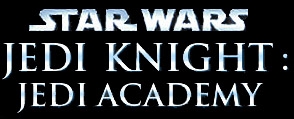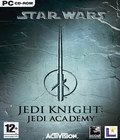Genre: FPS
Publisher: LucasArts
Developer: Raven Software
Release Date: September 16, 2003
Buy 'STAR WARS JEDI KNIGHT: Jedi Academy': Xbox | PC
Remember when Star Wars games sucked? I do. Sure, there have always been a few worthy titles in the franchise, but then again there has always been plenty of crappy pod racing games as well. It seems George “Jar Jar Binks” Lucas and company are finally starting to wise up, releasing Star Wars branded games that perfectly compliment the films and other assorted media. Jedi Knight: Jedi Academy is the latest Star Wars game to come down the pipeline and like its Jedi Knight predecessors it manages to up the watermark substantially. Taking all the great things from Jedi Outcast and expanding on most of them exponentially, Jedi Academy is certainly worthy of the Star Wars name.
This time around you’ll play as Jaden, a fresh-off-the-production-line Jedi recruit. Sadly, Kyle Katarn from Jedi Outcast is not the protagonist, but he does stand in as a well-learned teacher at the academy along with the legendary Luke Skywalker. While you have no choice but to be Jaden in Jedi Academy, you are able to customize Jaden’s characteristics at the beginning of the game. Jaden can be male or female, human or alien, and can also sport different garbs and facial additions.
Shortly after boarding the transport to Jedi Academy, Jaden’s ship goes down, crash landing near its destination after being attacked by unknown culprits. You and another student named Rosh are the only survivors. It isn’t long before Rosh starts showing signs of disdain and jealousy towards you due to Jaden’s superior Jedi abilities. After a quick training session/tutorial, you’ll set out on a group of five separate missions that should bring you up to date on the various gameplay nuances and slight control alterations that Jedi Academy has undergone since Outcast.
The assortment of missions you’ll tackle in Jedi Academy are refreshingly varied and offer a range of different environments and objectives. You’ll never know what to expect upon agreeing to a mission, and that’s half the fun. In one mission you’ll be scaling a series of aerial trams in an attempt to shut it down before the bad guys get away, while another mission will throw you into a desolate planet that is infested with sand worms where you must scavenge the area for spare parts to repair your ship. There are also plenty of familiar locales to sate fans of past games and movies, but the developers also went to great lengths to ensure that there will be plenty of new stuff to see.
Every time you agree to a mission you’ll get to choose from a variety of different weapons to take with you: two ranged weapons and one grenade type. Though your choices here are pretty irrelevant since you’ll inevitably end up with every available weapon during the course of the mission anyway. Once you complete a mission you’ll get to distribute a single Force point among the available Force powers at your disposal. You start the game with eight unique Force powers (push, pull, speed, jump, sense, saber offense, saber defense, and saber throw), but as you progress you’ll learn new abilities from both the light and dark side. Your base Force powers are sometimes required to progress in certain areas while the optional Force powers are used primarily to smooth the process along (healing, protection, Force grab, etc). While not all of the Force powers are necessary to complete the game you’ll invariably end up using them simply because of how useful they are in or after the heat of a battle.
While Jedi Outcast featured some pretty entertaining light saber combat, it didn’t give you the option to harness a light saber until a few hours into the game. Jedi Academy on the other hand gives you a light saber right from the get-go. Jedi Academy features plenty of interesting ranged weapons, but the focus here is on mastering the light saber. Automatically batting away energy artillery gives you a great advantage in combat, and the buttery smooth slicing and dicing that you’ll be able to effortlessly pull off is immensely satisfying.
Which brings me to the addition of saber styles. In Jedi Academy you’ll get to learn new stances and obtain different types of light sabers ranging from the down-and-dirty single saber to the quick-and-deadly saber staff that Dark Maul pimped in Episode 1. You can also learn how to equip two light sabers simultaneously, which is perfect for dealing with a far off opponent by using a Force throw while still being able to repel any incoming enemy fire with the other. The different stances you can learn are great for players who prefer quickness over power or vice versa. As a bonus you can execute kicks on nearby opponents while you have the saber staff equipped. The sheer variety in light saber combat in Jedi Academy adds greatly to the overall depth of the game and is a far cry from Outcast’s one-trick-pony light saber proceedings.
The multiplayer component in Jedi Academy is also surprisingly varied and well-structured. Obligatory additions such as standard deathmatch and capture-the-flag make an appreciated return. But Jedi Academy also introduces two new multiplayer modes that should prove entertaining well after the main game mode has been exhausted. Power Duel is a two-on-one battle to the death and Siege is a class-based team mode where players will have to work together in order to claim victory. For those with drastically high ping rates or just an anti-social tendency, bots can be seamlessly integrated into the multiplayer modes.
Visually, Jedi Academy offers up lots of spacious outdoor and indoor environments to tool around in, though graphics hounds will be hard-pressed to find much in the way of new-fangled visual additions. Jedi Academy uses the aging Quake III engine to render its non-stop action, which means that the control is spot-on but also that the graphics are somewhat lacking when compared to newer technology. But even so, everything you’ll see on-screen has been given loving attention to detail and double-checked for consistency, not to mention the guaranteed compatibility that the Quake III has with older video cards.
The audio presentation will certainly help to immerse the player into a Star Wars-themed universe with its classic music that has been heard in past games and lots of new orchestrations as well. The voice acting is a little stilted in places but almost always does a great job of conveying what needs to be said in order to advance the story. Sound effects, such as the throbbing swooshes of a light saber and heavy artillery bouncing off nearby objects is absolutely perfect.
 Overall, fans of past Jedi Knight games and of the FPS genre in general should find a whole lot to like in Jedi Knight: Jedi Academy. Any complaints that can be lodged at this game can easily be boiled down to nitpicking. What matters here is that the action is fast, fun, and satisfying. Jedi Academy is an excellent addition to the host of other great Star Wars games of past and present.
Overall, fans of past Jedi Knight games and of the FPS genre in general should find a whole lot to like in Jedi Knight: Jedi Academy. Any complaints that can be lodged at this game can easily be boiled down to nitpicking. What matters here is that the action is fast, fun, and satisfying. Jedi Academy is an excellent addition to the host of other great Star Wars games of past and present.
Score: 8.7/10
More articles about Star Wars Jedi Knight: Jedi Academy











 Star Wars Jedi Knight: Jedi Academy is a first- and third-person shooter action video game set in the Star Wars universe, and is the final entry in the Star Wars: Jedi Knight game series.
Star Wars Jedi Knight: Jedi Academy is a first- and third-person shooter action video game set in the Star Wars universe, and is the final entry in the Star Wars: Jedi Knight game series.


































